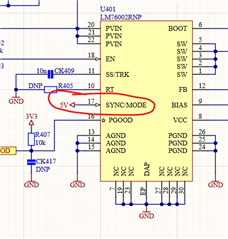Hi Team,
we have used the LM76002 in several of our designs already and we're very pleased with its performance. We mostly use the converter to create a 5V supply from a 24V input.
Now, I've just stumbled across this thread, which has made us a little insecure about our design:
Long story short, we're always using the LM76002 in FPWM mode and we're therefore pulling the SYNC/MODE pin high. Now, as mentioned in the linked thread above, we were also thinking that loading of the VCC pin on the LM76002 is not allowed (as mentioned in the datasheet) and therefore pulled SYNC/MODE high by directly connecting the pin to the 5V output voltage of the buck converter. Do you see any issue with doing that? Since there is no statement about the SYNC/MODE pin voltage range in the "Recommended Operating Conditions" section of the datasheet but only a 5.5V Abs Max Rating, we're a little worried if the pin is intended to be driven by 5V directly.
We would really appreciate it, if you could provide some clarification regarding this topic.

Thanks and best regards,
Sebastian


